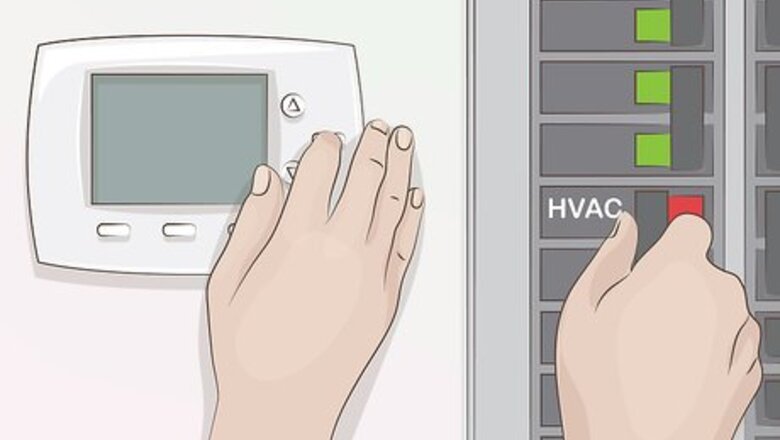
views
Vacuuming Out Clogged AC Drain Lines
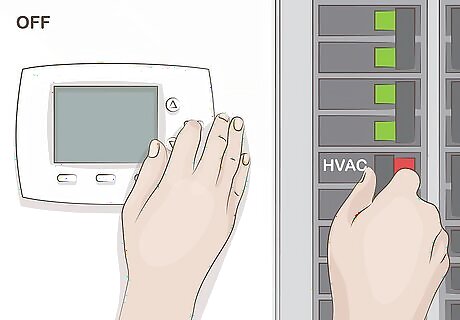
Turn off the power to your AC unit before you clean it. Turn off the AC unit at the thermostat first. Turn off the electrical breaker that powers the unit next. This will prevent any electrical accidents during cleaning. The breaker box is usually located on the ground floor of your home, or the basement if you have one, and sometimes in a storage room or the garage if you have one of those. Check these spots for the breaker box. If the switches aren't labeled, then you will have to try turning several off, and seeing if the AC is turned off, in order to find the corresponding breaker.
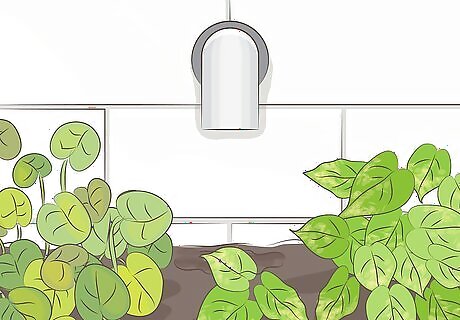
Locate the end of the drain line outside your home. The exit point of the drain line is usually located outside your home near the condenser unit of the AC system. Look for a PVC pipe coming out of the wall of your home and draining into the ground. Tip: In some cases, the drain line may not be located outside by the condenser unit. If you don’t see an exit point outside your home, then another possible drainage location is a bathroom drain or other drain somewhere inside your home. When you locate the drain line’s exit point, you can also check for any obvious obstructions right at the end of the drain. Remove anything obviously clogging the drain with gloved hands or a pair of pliers if it is hard to reach. If you don’t see anything, then proceed with vacuuming it out.
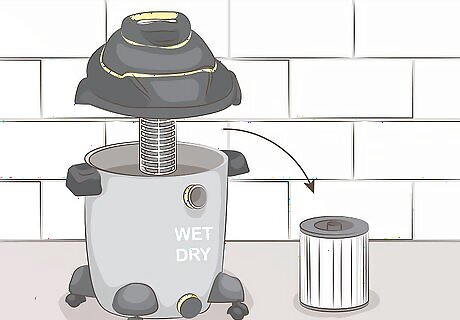
Remove the paper or cloth filter from a wet/dry vac so it doesn’t get ruined. Open up the vacuum and remove the filter. This will keep it from getting damaged by the water you are going to suck out and keep it clean of any mold or mildew. Depending on your model of wet/dry vac, you may be able to vacuum up small amounts of water with the filter in. Just keep in mind that you need to remove it, rinse it thoroughly with clean water, and let it dry completely after vacuuming any water and clogs to prevent mold and mildew from growing on it. Any standard wet/dry vac will work for this job. If you don't have one, you can often rent one from a hardware store.
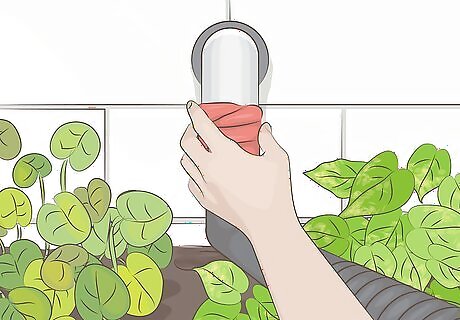
Connect the vacuum hose to the end of the drain line with a tightly-wrapped cloth. Put the tip of the vacuum hose to the end of the drain line so they overlap if possible. Wrap a cloth tightly around where they connect and hold it firmly with one hand to make a strong seal. You can also wrap duct tape around the connection to create a tight seal instead of holding the hose and the drain together with a cloth.
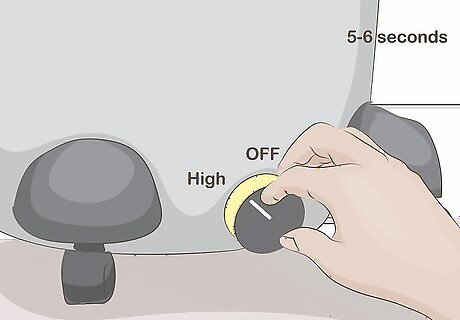
Turn the vacuum on high for 5-6 seconds to clear the clog. Turn on the wet/dry vac to the highest suction power for 5-6 seconds. Check the vacuum’s waste holding compartment to see if you sucked out the clog. If the clog persists, then keep running the vacuum in intervals of 5-6 seconds until you have run it for a total of 1 minute. If you are unable to clear the clog this way after a full minute, then you may need to call an HVAC company to come inspect your unit. You can make sure you cleared the clog by pouring some water into the drain line’s access hole, located inside your home where the drain line comes out of the unit, and watching to see if it runs out the other end. Once you are sure you have cleared the clog, turn the AC unit back on and test it to make sure it is running as normal.
Killing Mold and Mildew with Bleach to Prevent Clogs
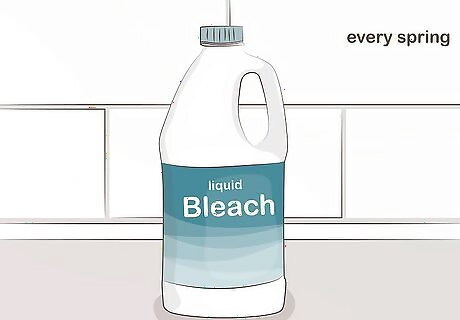
Clean out your AC drain line with bleach each spring to keep it clear. Pouring bleach into your AC unit’s drain line in early springtime before you start using it for the summer will kill and prevent buildup of mold and mildew. Do this every 6 months if you live in a particularly hot and humid region and use your AC more. If you perform this yearly maintenance on your AC unit’s drain line, you will be able to keep it clear and you shouldn’t need to vacuum any clogs out.
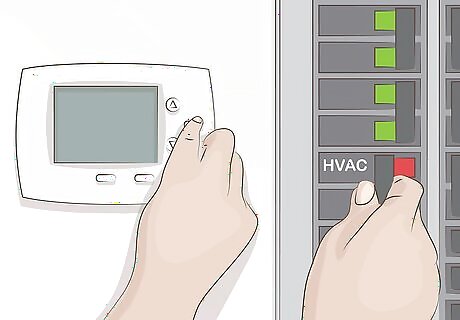
Turn off your AC unit’s power before you perform maintenance. Turn off the AC unit’s power at the thermostat. Turn off the breaker that supplies power to the AC system as well. This will eliminate the risk of any electrical accidents while you perform maintenance to keep your AC system’s drain line clean. Check in the basement, a storage room, the garage, or a hallway of the ground floor of your home to find the breaker box. Experiment with turning off different switches and checking which one turns off the AC unit if the switches aren't labeled.
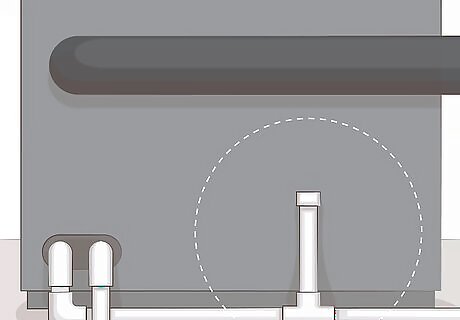
Locate the access hole for the drain line and remove the PVC cap. Look by the AC unit’s air handler inside your home for a T-shaped PVC pipe running out of it. Take off the cap at the top of the PVC pipe that goes straight up in the air to open the access hole. If you already know that the AC drain line is clogged, then you need to vacuum it out first before proceeding to clean it with bleach. After you clear the clog, clean it with bleach right away to kill off any remaining mold and mildew and prevent it from growing back.
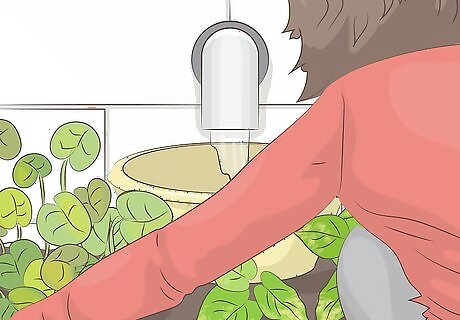
Have a helper watch the exit point of the drain line to see if it drains. Ask someone to watch the end of the drain line outside when you pour the bleach in the access hole. You will know that the drain line is clogged if they don't see anything coming out the other end. Tip: Place a bucket or other container underneath the drain line’s exit point to catch the bleach you pour through to dispose of and determine whether it is draining properly if you are working alone. The exit point of the drain line is normally outside your home next to the AC unit’s condenser. If it’s not, it may be located inside your home next to a bathroom drain or other drainage point. If nothing comes out the other end, then the drain line is clogged and you will need to vacuum it out before proceeding.
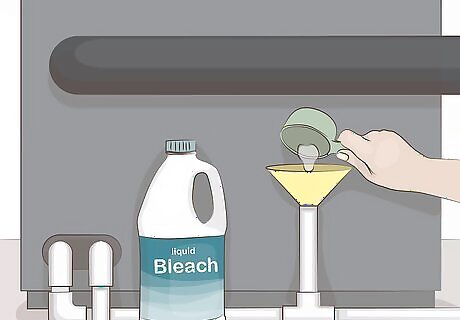
Pour 1 cup (236.5 ml) of bleach into the hole to kill the mold and mildew. Measure out 1 cup (236.5 ml) of bleach into a measuring cup with a pouring spout. Pour it into the access hole and let it drain out the other side. Use a funnel to help you get all the bleach into the drain line if it is easier.
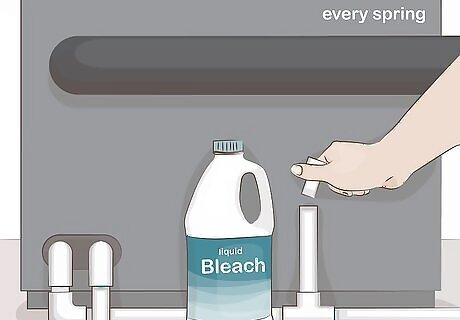
Do this every spring before you start using your AC unit to keep it clear. Pouring bleach into your AC unit’s drain line in early springtime before you start using it for the summer will kill and prevent buildup of mold and mildew. Do this every 6 months if you live in a particularly hot and humid region and use your AC more. If you perform this yearly maintenance on your AC unit’s drain line, you will be able to keep it clear and you shouldn’t need to vacuum any clogs out.




















Comments
0 comment